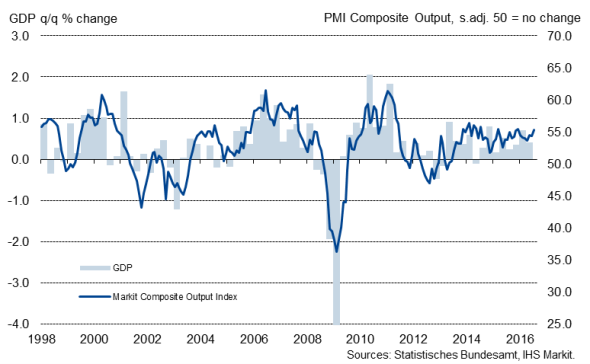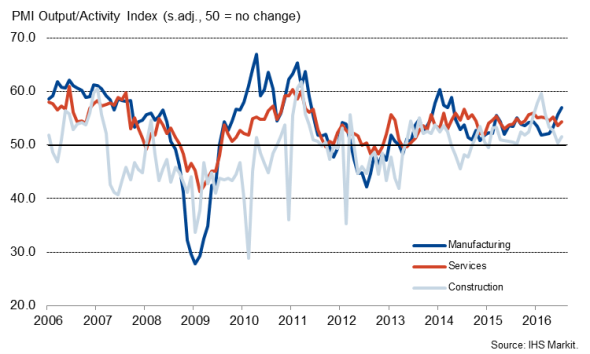German economy grows 0.4% in second quarter
The German economy continued its uninterrupted upwards trend in the second quarter of 2016. Statistisches Bundesamt Destatis reported that gross domestic product (GDP) rose by 0.4% in the three months to June, thereby moving back into line with Markit's PMI data. It was widely expected that the official data would show some payback from a surprisingly strong 0.7% expansion in the opening quarter and survey data such as the PMI have pointed to a steadier path of economic growth.
German economic growth and the PMI

Although no details were revealed, Destatis reported that net trade and both household final consumption expenditure and government expenditure supported growth in the three months to June. The positive net trade balance was only partly due to rising exports, however, as imports declined since the previous quarter.
Industry acts as drag on growth
Meanwhile, industry acted as a drag on GDP in the second quarter. Industrial production fell 1.0% in the three months to June, having risen 1.7% in the first quarter. It was widely anticipated that industry would not be able to match the substantial expansion from the beginning of the year. Nonetheless, over the first half of the year as a whole, industrial production was up 1.0% compared to the second half of 2015.
The official press release states that "a decline was especially recorded in gross fixed capital formation in machinery and equipment and in construction". The solid rise in building activity at the beginning of the year always looked to be short-lived and was at least in part due to a weather-induced spike during the unusually mild winter. The slowdown in the second quarter was also anticipated by the survey data, with the Construction PMI reaching levels not seen for five years at the start of the year before falling to a near-stagnation mark in June.
PMI output indices

Steady growth maintained at start of Q3
What can be expected as we move into the second half of the year? Markit's PMI provide a clear indication that the German economy remained on its steady growth path in July. While construction rose only slightly, manufacturing output surged and service providers continued to record solid growth of activity. In fact, the output measure for the goods-producing sector reached a 27-month high in July and orders continued to flood in at a solid pace, boding well for the months ahead.
There remain some downside risks to the outlook, however. Faltering global demand is likely to limit German exports and consequences of Brexit could impact business and consumer confidence and undermine investment. That said, the German economy has shown some resilience against various headwinds over the past few years, including the Greek debt crisis, the Russian trade embargo and the global growth slowdown. The latest IHS Markit growth forecast sees the German economy expanding by 1.6% in 2016.
August's flash PMI results for the manufacturing and service sectors are scheduled to be released on 23rd August.
Oliver Kolodseike | Economist, Markit
Tel: +44 14 9146 1003
oliver.kolodseike@markit.com